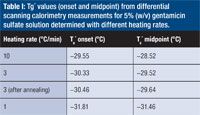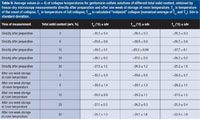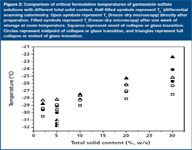Freeze-Drying Process Optimization for a Small Molecule
The authors evaluate the thermal properties of gentamicin sulfate as a small-molecule drug model in optimizing the freeze-drying cycle.
Compared with biopharmaceuticals, most freeze-dried small-molecule drugs are relatively inexpensive. To make their manufacture profitable, a high throughput without compromising the final quality is indispensable. The best approach to an optimized freeze-drying cycle is the reduction of primary drying time because this phase is commonly the most time-consuming part (1, 2). To follow this approach, an accurate and representative measurement of the critical formulation temperature (CFT) is required, which poses the upper boundary for the product temperature at the sublimation interface (Tp) during primary drying (2,3). With regard to process time and product-quality attributes, such as elegant-cake appearance, low residual moisture, quick and complete reconstitution, and drug activity, the product temperature over time profile during primary drying should be close to but below the CFT (2–4). In some cases, however, drying in the microcollapse regime is possible without severe structural loss as reported for protein formulations and could also be a promising approach to further process optimization for small molecule drugs (5–7). In this study, the thermal properties of gentamicin sulfate as a small-molecule model substance were characterized by means of freeze-dry microscopy (FDM) and differential scanning calorimetry (DSC) to determine the CFT at different concentrations and to investigate the potential for further freeze-drying cycle optimization.
Materials and methods
The pure gentamicin sulfate drug substance used for the thermal characterization was provided by Merck KGaA. Gentamicin sulfate solutions of 2, 5, 10, 20 and 30% (w/v) were prepared with deionized water.
DSC. The glass-transition temperature of the maximally freeze-concentrated solute (Tg´) for the 5% (w/v) gentamicin sulfate solution was determined using a differential scanning calorimeter (DSC822e, Mettler Toledo). Data analysis was conducted with software (STARe Software V 9.01, Mettler Toledo), and values were provided as "onset" and "midpoint" (i.e., half height) of the transition. 30 µL of sample solution were hermetically sealed in a 40-µL aluminum pan, cooled down to –80 °C at a cooling rate of 5 °C/min, equilibrated for 10 min and reheated at 10, 3, and 1 °C/min. For one sample measured with a heating rate of 3 °C/min, an annealing step was implemented for 90 min at –20°C. Nitrogen was used to purge the measuring cell throughout the experiment.
FDM. Collapse temperatures (Tc) for the 2, 5, 10, 20, and 30% (w/v) sample solutions were investigated directly after preparation and after one week of storage at room temperature. Validation of the temperature sensor and classification of collapse behavior were conducted according to the literature, and results are reported as an average of four measurements (8). The FDM equipment consisted of a microscope (Zeiss Imager.A1 microscope, Zeiss) with a polarizer, a lambda disk, and a freeze-drying stage (FDCS 196, Linkam Scientific Instruments). For each measurement, a sample volume of 2 µL was pipetted onto a cover glass lying on the silver block oven of the stage. A smaller cover glass was placed on top of this drop. Constant layer thickness was assured by using custom-made metal pieces (i.e., 25 µm) as spacers. To improve thermal contact between the bottom cover glass and the oven, a droplet of silicon oil was added. The sample droplet was frozen at a rate of 1.0 °C/min and equilibrated at –45°C for 10–13 min depending on the velocity of the sublimation interface. After 8 min of equilibration, the vacuum pump was switched on and subsequently sublimation could be observed. The sample was heated at a rate of 1.0 °C/min following the equilibration step. The magnification used during the experiments was 200-fold. Pictures were captured by the software in 1-second intervals using a digital camera (Pixelink, 1.3 MP) and analyzed with the LinkSys 32 software (Linkam Scientific Instruments). The stage was purged with dry nitrogen during freezing and heating. Pressure was measured using a calibrated Pirani gauge (Linkam Scientific Instruments) The maximum achievable vacuum (< 0.03 mbar) was kept constant throughout the measurement.
Results and discussion
DSC. As reported in the literature, Tg´ does not significantly change with concentration because the composition of the maximally freeze-concentrated solute is independent of the initial concentration (9). For this reason, only the 5% (w/v) solution was investigated by DSC. At first, the sample solution was scanned with a 10 °C/min heating rate to roughly detect the temperature range of Tg´. A fast heating rate increases sensitivity but can also impair representativeness of the measurement by shifting Tg´ to higher temperatures (9). To obtain the true result, additional heating rates of 3 and 1 °C/min were applied. Results are summarized in Table I, where the Tg´ onset and midpoint values are listed to illustrate the magnitude of the transition. The implementation of an annealing step revealed a glass transition that was comparable to the experiment without annealing regarding extend and temperature range. Crystallization of gentamicin sulfate, therefore is not expected.

Table I: Tg’ values (onset and midpoint) from differential scanning calorimetry measurements for 5% (w/v) gentamicin sulfate solution determined with different heating rates.
FDM. The collapse behavior of gentamicin sulfate solution is exemplarily shown in Figure 1 for the 5% (w/v) sample. Figure 1(a) shows the typical appearance of the drying sample at a temperature where no collapse occurred yet. The dark and dense matrix on the left represents the already dried amorphous matrix while the colorful area on the right shows the frozen structure. With proceeding drying, the sublimation interface progresses, in this case, from left to right. The temperature of the onset of collapse (Toc) is reached when the first structural changes can be visibly detected by formation of little pink holes or fissures in the dried structure adjacent to the sublimation interface as a result of viscous flow (see Figure 1(b)). During ongoing sublimation, the initial holes and gaps grow until the temperature of full collapse (Tfc) is reached, where the structural loss is so severe that there is no coherent dried-product matrix any more (see Figure 1(c)). Table II summarizes the results of the FDM measurements. As reported earlier, Tc is not a material constant but depends on concentration (3, 10, 11). In the case of gentamicin sulfate, an increase of approximately 3 °C can be observed in the range of 2 to 30% total solid content. The gap between Toc and Tfc (also denoted as the microcollapse regime) can offer valuable information about the temperature tolerance of the product (5). Depending on the formulation, this temperature range can widen up to 10 or 15 °C (7, 8, 12), and recent publications describe primary drying in the microcollapse region without significant macroscopic structural loss (5–7). With a difference of about 2 °C, the gap between Toc and Tfc for the presented measurements is relatively small and does not increase distinctly with concentration.

Figure 1: Freeze-dry microscopy pictures of the collapse behavior of 5% (w/v) gentamicin sulfate solution: (a): intact dried matrix, no collapse; (b) onset of collapse, arrows indicate first visible changes; and (c) full collapse, loss of coherent product matrix.
FDM measurements were repeated after one week of storage at room temperature to investigate potential instability of the solution that may lead to changes in Tc. Regarding the standard deviations, no clear difference between immediate measurements and experiments after one week of storage can be observed. It is important to note that at higher concentrations, the visual detection of collapse becomes more difficult. Due to the increased density of the sample and, therefore, reduced translucence, variations between replicate measurements increase.

Table II: Average values (n = 4) of collapse temperatures for gentamicin sulfate solutions of different total solid content, obtained by freeze-dry microscopy measurements directly after preparation and after one week of storage at room temperature. Toc is temperature of the onset of collapse; Tfc is temperature of full collapse; Tc-50 is calculated "midpoint" collapse (numerical average of Toc and Tfc). Sdv is standard deviation.
Comparison of DSC and FDM data. Tg´ and Tc are not identical as the measurement methodologies are different. Collapse describes a dynamic process because sublimation actually takes place during a FDM experiment, and the observed structural changes occur in the already dried matrix. In contrast, during the DSC measurement, the amorphous drug is in direct contact with ice without a drying process. Therefore, the experimental conditions of a FDM measurement better simulate those of a real freeze-drying run, and the structural changes can be visually observed. Moreover, Tg´ values are commonly reported as midpoint while the collapse temperature mostly refers to the onset of collapse. To roughly estimate a 50% structural loss in the dried matrix (midpoint) and to simplify comparison to DSC data, Tc-50 was introduced as a calculated average of Toc and Tfc (8). Figure 2 illustrates the CFTs determined with both methods during the present study. As previously described in the literature (2, 8, 12), Tg´ in the authors' study is lower than Toc, with greater difference at higher total solid content. For example, Toc of the 5% solution is about 2 °C higher, and at 30% total solid content, the difference amounts to approximately 4 °C compared to the midpoint Tg´. Taking Tc-50 into account, the gap ranges from 2.6 °C (5% w/v) to about 5 °C at 30% w/v for the measurement series directly after preparation. Regarding the fact that an increase of only 1 °C in product temperature during primary drying can reduce cycle time up to 13%, the application of Toc instead of Tg´ clearly permits more space for cycle optimization, especially at higher concentrations (13).

Figure 2: Comparison of critical formulation temperatures of gentamicin sulfate solutions with different total solid content. Half-filled symbols represent Tg´ (differential scanning calorimetry. Open symbols represent Tc (freeze-dry microscopy) directly after preparation. Filled symbols represent Tc (freeze-dry microscopy) after one week of storage at room temperature. Squares represent onset of collapse or glass transition. Circles represent midpoint of collapse or glass transition, and triangles represent full collapse or endset of glass transition.
Conclusion
The results of this study show that even for the relatively simple solution of a pure small-molecule drug, the collapse temperature determined by FDM can be considered as the practically more relevant CFT for process development and optimization. The direct observation of the collapse event and the width of the gap between Toc and Tfc can provide additional valuable information on the temperature tolerance of the sample. In the case of gentamicin sulfate, the temperature difference is not as big as it has been reported for protein formulations, indicating low robustness of the dried material in the microcollapse regime. Considering the great influence of small differences in product temperature on primary drying time and product morphology, the use of freeze-dry microscopy is a substantial contribution to efficiency and quality in the freeze-drying of small molecules.
Click here for video on the process of taking freeze-dry microscopic measurements
Acknowledgments
The authors acknowledge Hiltrud Lindenblatt, PhD, and senior scientist of life-cycle management CMC management at Merck KGaA, for providing the gentamicin sulfate.
Henning Gieseler* is an assistant professor and group leader in the Freeze-Drying Focus Group, Division of Pharmaceutics, University of Erlangen (Erlangen, Germany), and managing director of Gilyos GmbH, 15 Friedrich-Bergius-Ring, Wuerzburg, Germany, 97076, tel. +49 931 907 05678, info@gilyos.comSusanne Hibler is a graduate student in the Freeze-Drying Focus Group, Division of Pharmaceutics, University of Erlangen.
References
1. S. Rambhatla and M.J. Pikal, "Heat and Mass Transfer Issues in Freeze-drying Process Development," in Lyophilization of Biopharmaceuticals, H. R. Constantino and M.J. Pikal, Eds. (American Association of Pharmaceutical Scientists, Arlington, 1st ed., 2004), pp 75–109.
2. X. Tang and M.J. Pikal, Pharm. Res.21 (2), 191–200 (2004).
3. M.J. Pikal and S. Shah, Int. J. Pharm. 62 (2–3), 165–186 (1990).
4. J.F. Carpenter et al., Pharm. Res. 14 (8), 969–975 (1997).
5. R.E. Johnson et al., J. Pharm. Sci. 99 (6), 2863–2873 (2010).
6. D.E. Overcashier, T.W. Patapoff, and C.C. Hsu, J. Pharm. Sci. 88 (7), 688–695 (1999).
7. J.D. Colandene et al. J. Pharm. Sci.96 (6), 1598–1608 (2007).
8. E. Meister and H. Gieseler, J. Pharm. Sci. 98 (9), 3072–3087 (2009).
9. L.M. Her and S.L. Nail, Pharm. Res. 11 (1), 54–59 (1994).
10. J. Liu, Pharm. Dev. Technol. 11 (1), 3–28 (2006).
11. E. Meister, Methodology, Data Interpretation and Practical Transfer of Freeze-Dry Microscopy, PhD. Thesis, Friedrich-Alexander-Universität Erlangen-Nürnberg, Erlangen (2009).
12. F. Fonseca et al., Biotechnol. Prog. 20 (1), 229–238 (2004).
13. M.J. Pikal, J. Parenter. Sci. Technol. 39 (3), 115–139 (1985).

Drug Solutions Podcast: A Closer Look at mRNA in Oncology and Vaccines
April 30th 2024In this episode fo the Drug Solutions Podcast, etherna’s vice-president of Technology and Innovation, Stefaan De Koker, discusses the merits and challenges of using mRNA as the foundation for therapeutics in oncology as well as for vaccines.